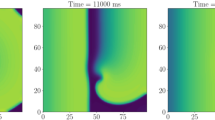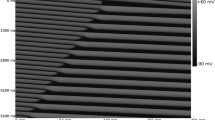Abstract
Limitations of antiarrhythmic drugs on cardiac sudden death prevention appeared since the early 80's. The "Cardiac Arrhythmia Suppression Trial"(CAST) showed more recently that mortality was significantly higher inpatients treated with some particular antiarrhythmic drugs than in non-treated patients. In this field, our group recently demonstrated that a bolus of a Class 1B antiarrhythmic drug was able to trigger a ventricular fibrillation due to transient blocks induction.
The aim of the present work was to systematically study, by use of the van Capelle and Durrer (VCD) model which allows to simulate ventricular activation wave propagation, the link between arrhythmogenic effects and the ability of transient blocks to possibly degenerate in severe arrhythmias. A fragment of the ventricular wall is represented by an array of 16384elements electrically coupled. Effects of induction of one or several transient blocks, as the effects of their size and duration on possible induction of reentries have been studied. Results obtained show that various combinations between these different parameters may trigger reentries, ventricular tachycardia and/or more complex patterns assimilable to ventricular fibrillation. These results clearly evidence the fact that possible induction of transient blocks may directly be related to risk factor associated to arrhythmogenic effects of antiarrhythmic drugs.
Similar content being viewed by others
REFERENCES
Auger, P., A. Coulombe, P. Dumée, M-C. Govaere, J-M, Chesnais and A. Bardou (1991). Computer simulation of cardiac arrhythmias and of defibrillating electric shocks. Effects of antiarrhythmic drugs. In: M. Remoissenet and M. Peyrard, eds., Nonlinear Coherent Structures in Physics and in Biology, Lecture notes in Physics Vol. 394, p. 133–140. Berlin, Springer Verlag.
Bardou, A., P. Auger, R. Cardinal, P. Dumée, P. Birkui, D. Von Euw and M-C. Govaere (1993). Theoretical study by means of computer simulation of conditions in which extrasystoles can trigger ventricular fibrillation. Validation by epicardial mappings. J. Biological Systems 1(2): 147–158.
Bigger T.J. and D.I. Sahar (1987). Clinical types of proarrhythmic response to antiarrhythmic drugs. Amer. J. Cardiol. 59: 2E–9E.
Cabo, C., A. Pertsov, W.T. Baxter, J.M. Davidenko, R. Gray and J. Jalife (1994). Wave-front curvature as a cause of slow conduction and block in isolated cardiac muscle. Circ. Res. 75: 1014–1028.
Horowitz L.N., D.P. Zipes, R.W. Campbell, J. Morganroth, B. Podrid, M.R. Rosen and R.L. Woosley (1987). Proarrhythmia, arrhythmogenesis or aggravation of arrhythmia-a status report. Amer. J. Cardiol. 59: 54E–56E.
Landau, M., P. Lorente, D. Michaels and J. Jalife (1990). Bistabilities and annihilation phenomena in electrophysiological cardiac models. Circ. Res. 66: 1658–1672.
Rinkenberger, R.L., E.N. Prytowsky, W.M. Jackman, G.V. Naccarelli, J.J. Heger and D.P. Zipes (1982). Conversion of nonsustained ventricular tachycardia during serial electrophysiologic studies: identification of drugs that exacerbare tachycardia and potential mechanisms. Amer. Heart J. 103: 172–184.
Rogers, J.M. and A.D. Mc Culloch (1994a). Nonuniform muscle fiber orientation causes spiral waves drift in a finite element model of cardiac action potential propagation. J. Cardiovasc. Electrophysiol. 5: 496–509.
Rogers, J.M. and A.D. Mc Culloch (1994b). A collocation-Galerkin finite element model of cardiac action potential propagation. IEEE Transactions on Biomedical Engineering. 41: 743–757.
Slater, W., S. Lampertr, P.J. Podrir and B. Lown (1988). Clinical predictors of arrhythmias worsening by antiarrhythmic drugs. Amer. J. Cardiol 61: 349–353.
The Cardiac Arrhythmia Suppresion Trial (CAST) Investigators (1989). Preliminary report: effect of encaidine and flecaidine on mortality in a randomized trial of arrhythmia suppression after myocardial infarction. New Engl. J. Med. 321: 406–412.
van Capelle, F.J. and D. Durrer (1980). Computer simulation of arrhythmias in a network of coupled excitable elements. Circ. Res. 47: 454–466.
Velbit, V., P. Podrid, B. Lown, B.M. Cohen and T.B. Graboys (1982). Aggravation and provocation of ventricular arrhythmias by antiarrhythmic drugs. Circulation 65: 886–894.
Yang, H., N. El-Sherif, N. Isber and M. Restivo (1994). A logical state model of circus movement atrial flutter. Role of anatomic obstacles, anisotropic conduction and slow conduction zones on induction, sustenance, and overdrive paced modulation of reentrant circuits. IEEE Transactions on Biomedical Engineering 41: 537–548.
Author information
Authors and Affiliations
Rights and permissions
About this article
Cite this article
Bardou, A.L., Auger, P.M., Chasse, JL. et al. Theoretical Study of Cardiac Transient Conduction Blocks on Reentries Induction. Applications to Antiarrhythmic Drugs. Acta Biotheor 45, 227–236 (1997). https://doi.org/10.1023/A:1000619607787
Issue Date:
DOI: https://doi.org/10.1023/A:1000619607787




